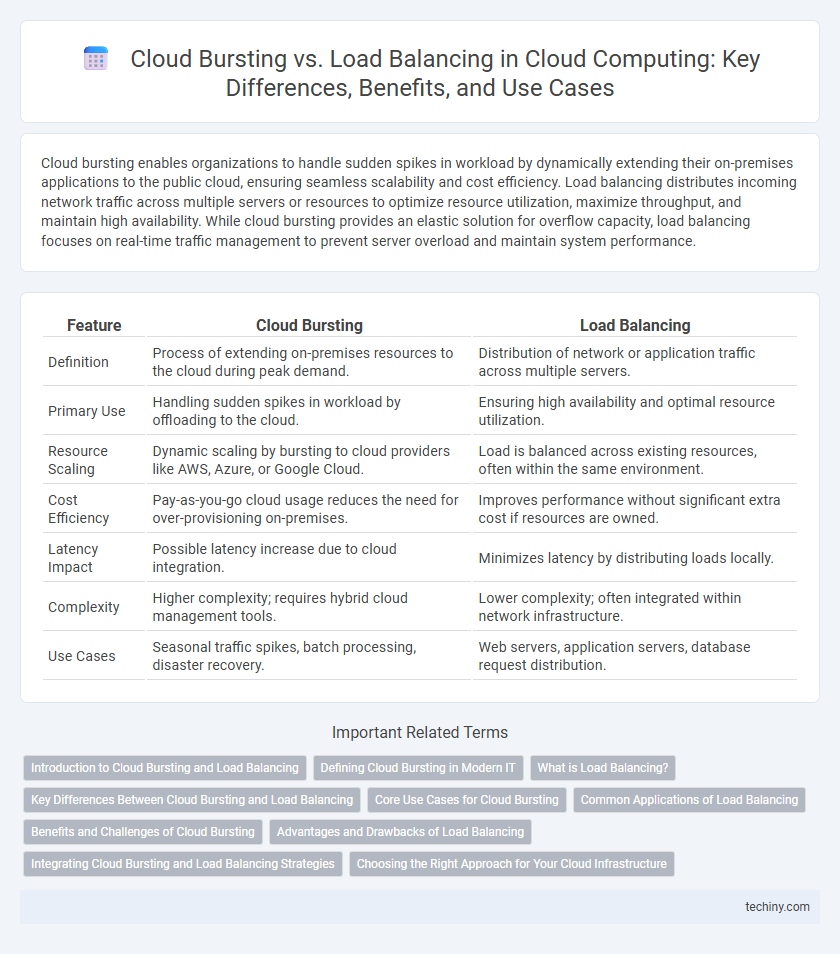Cloud bursting enables organizations to handle sudden spikes in workload by dynamically extending their on-premises applications to the public cloud, ensuring seamless scalability and cost efficiency. Load balancing distributes incoming network traffic across multiple servers or resources to optimize resource utilization, maximize throughput, and maintain high availability. While cloud bursting provides an elastic solution for overflow capacity, load balancing focuses on real-time traffic management to prevent server overload and maintain system performance.
Table of Comparison
| Feature | Cloud Bursting | Load Balancing |
|---|---|---|
| Definition | Process of extending on-premises resources to the cloud during peak demand. | Distribution of network or application traffic across multiple servers. |
| Primary Use | Handling sudden spikes in workload by offloading to the cloud. | Ensuring high availability and optimal resource utilization. |
| Resource Scaling | Dynamic scaling by bursting to cloud providers like AWS, Azure, or Google Cloud. | Load is balanced across existing resources, often within the same environment. |
| Cost Efficiency | Pay-as-you-go cloud usage reduces the need for over-provisioning on-premises. | Improves performance without significant extra cost if resources are owned. |
| Latency Impact | Possible latency increase due to cloud integration. | Minimizes latency by distributing loads locally. |
| Complexity | Higher complexity; requires hybrid cloud management tools. | Lower complexity; often integrated within network infrastructure. |
| Use Cases | Seasonal traffic spikes, batch processing, disaster recovery. | Web servers, application servers, database request distribution. |
Introduction to Cloud Bursting and Load Balancing
Cloud bursting enables on-premises applications to seamlessly extend into public clouds during peak demand, optimizing resource utilization while maintaining control over core workloads. Load balancing distributes incoming network traffic across multiple servers or cloud instances to ensure reliability, reduce latency, and maximize throughput. Both techniques enhance scalability and performance but address different aspects of cloud resource management.
Defining Cloud Bursting in Modern IT
Cloud bursting is a hybrid cloud deployment model that enables enterprises to offload overflow traffic from private cloud infrastructures to public clouds during peak demand periods. This dynamic resource allocation enhances scalability and cost-efficiency by leveraging additional computing power only when necessary. Unlike load balancing, which distributes workloads across multiple servers within a single environment, cloud bursting extends capacity beyond local resources to maintain performance and prevent service disruption.
What is Load Balancing?
Load balancing in cloud computing distributes incoming network traffic across multiple servers to ensure no single server becomes overwhelmed, enhancing application availability and reliability. It optimizes resource use by dynamically allocating workloads based on server capacity and current demand, reducing latency and preventing bottlenecks. Effective load balancing improves fault tolerance and supports scalability by seamlessly managing traffic spikes and maintaining consistent performance.
Key Differences Between Cloud Bursting and Load Balancing
Cloud bursting dynamically extends workloads to public clouds during traffic spikes, optimizing resource usage without permanent infrastructure expansion. Load balancing distributes incoming network traffic across multiple servers to ensure high availability and reliability under consistent demand. The key difference lies in cloud bursting's ability to handle unpredictable surges by leveraging hybrid cloud resources, whereas load balancing maintains steady performance by evenly allocating loads among active servers.
Core Use Cases for Cloud Bursting
Cloud bursting enables enterprises to handle sudden spikes in computing demand by dynamically offloading excess workloads from private clouds to public cloud resources, ensuring seamless scalability and cost efficiency during peak periods. It is particularly beneficial for applications with unpredictable traffic patterns, such as e-commerce sales events, batch processing, and disaster recovery scenarios, where maintaining performance without over-provisioning infrastructure is critical. Unlike load balancing, which distributes incoming traffic across multiple servers to optimize resource utilization, cloud bursting specifically extends capacity beyond on-premises limitations by leveraging hybrid cloud environments.
Common Applications of Load Balancing
Load balancing is commonly applied in web hosting, e-commerce platforms, and streaming services to distribute incoming traffic evenly across multiple servers, ensuring high availability and performance. It enhances fault tolerance by redirecting traffic from overloaded or failed servers to healthy ones, minimizing downtime. Load balancing also supports scalable application delivery in multi-cloud and hybrid cloud environments, improving resource utilization and user experience.
Benefits and Challenges of Cloud Bursting
Cloud bursting allows organizations to handle peak workloads by seamlessly extending capacity to public clouds, reducing costs associated with over-provisioning physical infrastructure. Benefits include on-demand scalability, improved resource utilization, and maintaining performance during traffic spikes. Challenges involve complex integration between private and public clouds, potential security risks, and latency issues due to data transfer across cloud environments.
Advantages and Drawbacks of Load Balancing
Load balancing in cloud computing optimizes resource utilization by distributing workloads evenly across multiple servers, enhancing application availability and reducing latency. It improves fault tolerance by redirecting traffic from failed or overloaded servers, ensuring uninterrupted service. However, load balancing requires complex configuration and ongoing management, potentially increasing operational costs and introducing a single point of failure if not properly designed.
Integrating Cloud Bursting and Load Balancing Strategies
Integrating cloud bursting and load balancing strategies enables dynamic resource allocation by offloading excess workloads to public clouds while evenly distributing traffic across servers to optimize performance and reduce latency. This combination improves application scalability, ensuring seamless handling of varying demand without over-provisioning on-premises infrastructure. Leveraging advanced orchestration tools and automated policies enhances cost efficiency and maintains service quality during peak usage periods.
Choosing the Right Approach for Your Cloud Infrastructure
Cloud bursting enables seamless overflow from private to public clouds during peak demand, optimizing resource utilization without overprovisioning. Load balancing distributes workloads evenly across multiple servers or cloud instances, ensuring high availability and consistent performance under normal conditions. Selecting the right approach depends on workload variability, cost considerations, and the criticality of maintaining uninterrupted service for your specific cloud infrastructure.
Cloud Bursting vs Load Balancing Infographic

 techiny.com
techiny.com